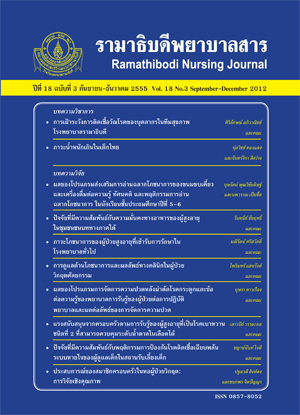ผลของการผ่อนคลายแบบเกร็งกล้ามเนื้อต่อระดับความวิตกกังวลในผู้ป่วย โรคหอบหืด
Main Article Content
Abstract
บทคัดย่อ
โรคหอบหืดเป็นโรคเรื้อรังซึ่งเกิดขึ้นได้บ่อยหากไม่มีการควบคุมโรคที่ดี ความวิตก กังวลเป็นปัจจัยหนึ่งซึ่งมีผลกระทบต่อผู้ป่วยโรคหอบหืด การฝึกการผ่อนคลายแบบเกร็งกล้าม เนื้อจึงเป็นกลวิธีหนึ่งที่จะช่วยบรรเทาและช่วยเหลือผู้ป่วยโรคหอบหืด การศึกษาวิจัยกึ่งทดลอง นี้ได้ศึกษาในผู้ป่วยโรคหอบหืดจำนวน 40 รายที่มีอายุระหว่าง 18-65 ปี ที่คลินิกโรคหอบหืด หน่วยอายุรกรรมผู้ป่วยนอกโรงพยาบาลรามาธิบดี กลุ่มตัวอย่างได้รับการแบ่งออกเป็นกลุ่ม ทดลองและกลุ่มควบคุม จำนวนกลุ่มละ 20 ราย ในกลุ่มควบคุมได้รับการรักษาตามปกติ ในขณะกลุ่มทดลองได้รับการฝึกการผ่อนคลายแบบเกร็งกล้ามเนื้อ 8 ครั้งร่วมกับการรักษาตาม ปกติ ซึ่งใช้ระยะเวลา 20 นาทีต่อรอบการฝึก ภายหลังการฝึกการผ่อนคลายแบบเกร็งกล้ามเนื้อ ทั้ง 2 กลุ่มได้รับการประเมินสัญญาณชีพและตอบแบบวัดความวิตกกังวล มีการวิเคราะห์ทาง สถิติโดยใช้ Student’s t test ผลการศึกษาพบว่าภายหลังการฝึกการผ่อนคลายแบบเกร็งกล้ามเนื้อ คะแนนเฉลี่ยของความวิตกกังวลในกลุ่มทดลองต่ำกว่ากลุ่มควบคุมอย่างมีนัยสำคัญทางสถิติ แต่ไม่พบความแตกต่างอย่างมีนัยสำคัญทางสถิติของค่าสัญญาณชีพของทั้ง 2 กลุ่ม อย่างไร ก็ตาม ความวิตกกังวลมักจะเป็นปัจจัยส่งเสริมให้อาการของโรคหอบหืดกำเริบขึ้น ดังนั้น ผลของ การฝึกการผ่อนคลายแบบเกร็งกล้ามเนื้อต่อการลดความวิตกกังวล น่าจะเป็นผลดีในการควบคุม อาการหอบหืด ผลของการวิจัยครั้งนี้ ชี้ให้เห็นว่าพยาบาลควรส่งเสริมกลวิธีดังกล่าวอย่างต่อเนื่อง เพื่อให้ผู้ป่วยมีคุณภาพชีวิตที่ดี
คำสำคัญ : การผ่อนคลายแบบเกร็งกล้ามเนื้อ, ความวิตกกังวล, สัญญาณชีพ, หอบหืด
Abstract
Asthma is a symptomatic and chronic disease that frequent attacks if it is not well-controlled. Anxiety, one of many factors, impacts asthmatic patients. A reduction of the anxiety by practicing progressive muscle relaxation is proposed as a strategy to help release and support patients with asthma. This quasi-experiment research was conducted in 40 patients with asthma aged from 18 to 65 years at the Asthma Out-Patients Clinic, Ramathibodi Hospital. These patients were assigned into the control group or the experimental group by taking turn the sequence. The control group was only provided with usual care, whereas the experimental group practiced eight sessions of progressive muscle relaxation, in addition to usual care, which took 20 minutes/practice. After the practice, vital signs of both groups were monitored and the sample were asked to respond to the State Anxiety Scale. Student’s t-test was used to analyze the data. The result showed that after the practice, the mean score of the anxiety in the experimental group was significantly lower than that in the control group. However, there was no significant difference in changes of vital signs in either group. Yet, anxiety is a precipitating factor for exacerbation of asthma, thus, the effectiveness of progressive muscle relaxation on reduced anxiety should be beneficial to control asthma symptoms. This research study suggested that nurses should continuously promote this strategy to assist patients in achieving good quality of life.
Keywords : Progressive muscle relaxation, Anxiety, Vital signs, Asthma
Article Details
บทความ ข้อมูล เนื้อหา รูปภาพ ฯลฯ ที่ได้รับการตีพิมพ์ในรามาธิบดีพยาบาลสาร ถือเป็นลิขสิทธิ์ของวารสาร หากบุคคลหรือหน่วยงานใดต้องการนำทั้งหมดหรือส่วนหนึ่งส่วนใดไปเผยแพร่หรือเพื่อกระทำการใด ใด จะต้องได้รับอนุญาตเป็นลายลักษณ์อักษรจากรามาธิบดีพยาบาลสารก่อนเท่านั้น


